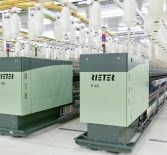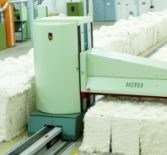
Textile fabrics are made by interweaving two mutually perpendicular systems of threads. Cross weft threads pass above and below the warp threads. When designing fabrics, you can change the pattern of weaving, creating new effects and different patterns of the finished fabric. There are three main (simple) types of weaving: plain, twill (twill) and satin. In plain weaving, the warp threads are spaced at equal distances from each other, and the weft thread (weft) passes alternately above or below the warp thread, i.e. it is either “raised” or “dropped”. With twill weaving, the weft rises and falls at varying intervals. If two or more weft pass over two or more warp threads with shifting intervals, then diagonal lines form on the surface of the fabric. Satin weaving is, in essence, a special kind of twill weaving: warp threads rise above a few weft and fall at large intervals. They cover the weft threads and a smooth, even surface forms.
The quality of the fabric is characterized by the grade, thickness and quality of the yarn, the density of the fabric, i.e. the number of weft and warp threads per square centimeter, and the type of finish. Stretch fabrics. Textile fabrics can be made from highly elastic yarn that can stretch very much and quickly restore its former shape. Sportswear, underwear, pajamas are made from such fabrics.
Knitwear
Jerseys are obtained by knitting - the formation of loops from yarn and their mutual interweaving. Due to the loop structure, such textile products are usually softer and more flexible than woven ones and do not form folds. The air gaps formed by the loops increase the thermal insulation and give the knitted fabric the ability to absorb moisture. Knitwear is especially suitable for hosiery, underwear and other types of clothing that do not restrict movement and at the same time tighten the body.
Knitted products can be knitted manually or on knitted machines. With hand knitting, loops are formed sequentially one after another, and in knit machines a large number of needles can knit yarn into loops at the same time. Cars are divided into flat and round. Flat knitted machines with needles arranged in a straight row are used to produce a flat knitted fabric. In round (circular knitting) machines, the needle bar with needles is round, and they are designed to produce a circular knitted fabric.
According to the structure, knitwear is divided into longitudinally knitted (warp knitted) and cross-knitted (culinary). In the warp knit weave, the chains of loops go in the longitudinal direction and are called looped columns, and in the cross knit - in the transverse direction and are called looped rows. Products with one and the other interlacing of threads can be made on both flat and round knit machines. On knitted cross-knitting machines, the laid thread is knitted sequentially on all needles, and on longitudinal knitting machines, a large number of threads are each laid on their own needle and then knitted in loops. Long-knit jersey is not as elastic as cross-knit, but it is stronger and practically does not open.
The most common weaves of machine knitwear are smooth, two-purl (reverse) and elastic. With smooth weaving, longitudinal looped rows are formed on the front side of the canvas and transverse ones on the wrong side. With a two-sided, successive looped rows are formed on opposite sides of the fabric, so that transverse scars are obtained on both sides. A lasting weave is a combination of the first two that gives vertical scars on both sides of the fabric.
Felt and felt products
Felt and felt products are obtained as a result of compaction of the fibers of the source material, rather than yarn.
The starting fibrous material is heated, moistened, pressed and (in the case of men's hats and other hard products) partially saturated with shellac. The amount of shellac added depends on the required hardness of the product.
The most suitable fibrous materials for felt and felt products are short-staple wool tows and fibers of rabbit fur, beaver and other similar animals. Felt and felt products can also be made from camel, cow, goat wool, waste from textile factories and various types of low-grade wool.
Nonwovens
Non-woven textile products are a layer of textile fibrous material (canvas), bound together by narrow strips of adhesive material. Bonding is ensured either by surface activation with chemicals, or by heating if thermoplastic fibers are used. The amount of bonding material is small compared to the amount of fiber.
Non-woven materials differ from felt-felt in the type of fibrous materials used and in the way they are bonded. Non-woven materials are made predominantly from chemical fibers that are not susceptible to coiling.
Basketry
Braided products are obtained by interlacing a series of threads diagonally and longitudinally so that a ribbon or braid is formed. The tape is usually not more than 10 cm wide, and it can be not only flat, but also round-braided.


